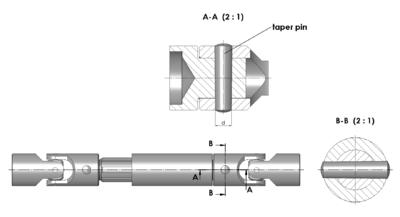A taper pin is a fastener used in mechanical engineering. They are steel rods with one end having a slightly larger diameter than the other. Standard inch-sized taper pins have a taper on diameter of 1:48[1] while metric ones have a taper of 1:50.[2] A 1:48 taper means that one end of a 4-foot-long bar (48 inches) will be 1 inch smaller in diameter than the other end, or a 1&fras1;4-inch taper over a 1-foot length. A 1:50 taper means that one end of a half-meter long bar (50 cm) will be 1 cm smaller in diameter than the other end, or a 2 mm taper over a decimeter length.
Some taper pins have a male screw thread on the small end that is designed to project through the hole and retain the pin with a washer and a nut. Other pins are threaded on both ends, on the thick end to pull the pin out with the same nut that holds the pin in place.
Taper pin reamers are designed to prepare the hole for taper pins. Metric taper reamers are designated by the small diameter. For example, a 2 mm taper pin reamer has a 1.9 mm small end (2 mm nominal size) and a 2.86 mm large end.[3]
References
- ^ Machinery's Handbook
- ^ Newnes Mechanical Engineer's Pocket Book
- ^ Newman Tools Inc., metric taper pin reamers
